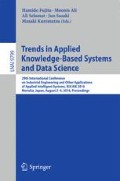Abstract
“Dimension direction” means the evaluation direction in decision making problem. Decision-making sometimes should consider multi-criteria, multi-period and multi-place. The criteria, period and place are different dimension direction for making decision. In special situation, decision maker must think over more than three dimension directions in the decision making problem. However, past research literatures at most consider two dimension directions. The goal of this research is to develop the execution process to deal with the decision making problem under multi dimension direction. Proposed execution process can flexibly apply in various kinds of multi dimension direction problem. A numerical example will be implemented. Some analysis and comparison will be executed. Conclusion and future research will be discussed as ending.
Access this chapter
Tax calculation will be finalised at checkout
Purchases are for personal use only
References
Figueira, J., Greco, S., Ehrgott, M.: Multiple Criteria Decision Analysis: State of the Art Surveys. Springer, New York (2005)
Pai, P.F., Chen, C.T., Hung, W.Z.: Applying linguistic information and intersection concept to improve effectiveness of multi-criteria decision analysis technology. Int. J. Inf. Technol. Decis. 13, 291–315 (2014)
Stark, J.: Product Lifecycle Management, pp. 1–16. Springer, London (2011)
Wang, X., Triantaphyllou, E.: Ranking irregularities when evaluating alternatives by using some ELECTRE methods. Omega 36, 45–63 (2008)
Wei, C.C., Chien, C.F., Wang, M.J.J.: An AHP-based approach to ERP system selection. Int. J. Prod. Econ. 96, 47–62 (2005)
Yüksel, İ., Dagdeviren, M.: Using the analytic network process (ANP) in a SWOT analysis–a case study for a textile firm. Inform. Sci. 177, 3364–3382 (2007)
Mousseau, V., Slowinski, R., Zielniewicz, P.: A user-oriented implementation of the ELECTRE-TRI method integrating preference elicitation support. Comput. Oper. Res. 27, 757–777 (2000)
Chen, Y.W., Tzeng, G.H.: Using fuzzy integral for evaluating subjectively perceived travel costs in a traffic assignment model. Eur. J. Oper. Res. 130, 653–664 (2001)
Behzadian, M., Kazemzadeh, R.B., Albadvi, A., Aghdasi, M.: PROMETHEE: a comprehensive literature review on methodologies and applications. Eur. J. Oper. Res. 200, 198–215 (2010)
Swiniarski, R.W., Skowron, A.: Rough set methods in feature selection and recognition. Pattern Recogn. Lett. 24, 833–849 (2003)
Chen, C.T.: Extensions of the TOPSIS for group decision-making under fuzzy environment. Fuzzy Set Syst. 114, 1–9 (2000)
Lahdelma, R., Salminen, P.: Pseudo-criteria versus linear utility function in stochastic multi-criteria acceptability analysis. Eur. J. Oper. Res. 141, 454–469 (2002)
Zou, Z.H., Yi, Y., Sun, J.N.: Entropy method for determination of weight of evaluating indicators in fuzzy synthetic evaluation for water quality assessment. J. Environ. Sci. 18, 1020–1023 (2006)
Xu, Z.: On multi-period multi-attribute decision making. Knowl. Based Syst. 21, 164–171 (2008)
Xu, Z., Da, Q.L.: An overview of operators for aggregating information. Int. J. Intell. Syst. 18, 953–969 (2003)
Author information
Authors and Affiliations
Corresponding author
Editor information
Editors and Affiliations
Rights and permissions
Copyright information
© 2016 Springer International Publishing Switzerland
About this paper
Cite this paper
Chen, YL. (2016). Decision Making Based on Different Dimension Direction. In: Fujita, H., Ali, M., Selamat, A., Sasaki, J., Kurematsu, M. (eds) Trends in Applied Knowledge-Based Systems and Data Science. IEA/AIE 2016. Lecture Notes in Computer Science(), vol 9799. Springer, Cham. https://doi.org/10.1007/978-3-319-42007-3_59
Download citation
DOI: https://doi.org/10.1007/978-3-319-42007-3_59
Published:
Publisher Name: Springer, Cham
Print ISBN: 978-3-319-42006-6
Online ISBN: 978-3-319-42007-3
eBook Packages: Computer ScienceComputer Science (R0)

